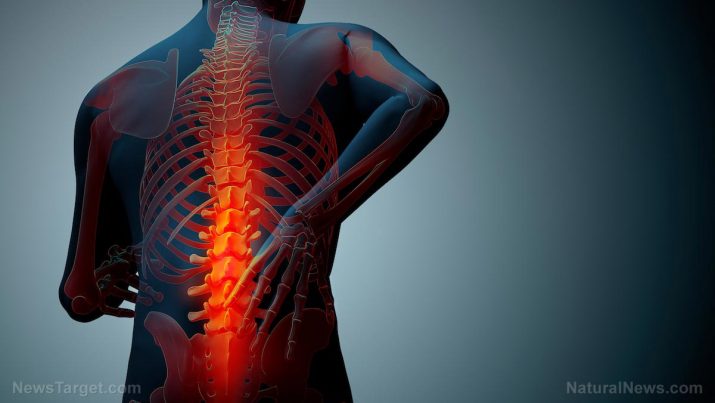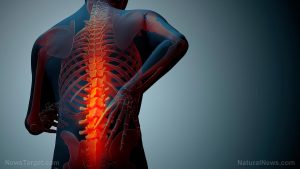
Sacrococcygeal chordoma – causes, side effects and treatments at NaturalPedia.com
Wednesday, August 01, 2018 by Zoey Sky
http://www.naturalpedia.com/sacrococcygeal-chordoma-causes-side-effects-and-treatments-at-naturalpedia-com.html

A sacrococcygeal chordoma is an uncommon and slow-growing type of bone cancer. Chordomas only make up less than one percent of central nervous system (CNS) tumors. At least 50 percent of these are sacrococcygeal chordomas, which form near the bottom of the spine.
The malignant tumor forms because of cells called “notochordal remnants” that are found at the sides of the vertebral column. Notochord refers to the embryonic structure that both the brain and spinal cord develop from during fetal development.

Known symptoms of sacrococcygeal chordoma
The symptoms of sacrococcygeal chordoma usually include:
- Lower back pain
- Pain that radiates to the legs
- Rectal and urinary incontinence
- A visible mass may also form near the bottom of the spine
Risk factors for sacrococcygeal chordoma may include:
- Being 40 to 75 years old
- Having tuberous sclerosis complex, a genetic syndrome
While having a positive family history of the condition means that you have a higher risk of developing a sacrococcygeal chordoma later in life, the majority of tumor occurrences are sporadic.
Body systems harmed by sacrococcygeal chordoma
Depending on the location of a sacrococcygeal chordoma and the surgical procedure performed, they may cause complications like local bone destruction. The tumors can also extend deep into the soft tissues.
The other complications linked to the condition include:
- Bowel and bladder dysfunction – May occur in patients with sacrococcygeal tumors.
- Distant metastasis of tumors – This is a very rare complication.
- Tumor recurrence – Occurs when a tumor isn’t completely removed after surgery.
Food items or nutrients that may prevent sacrococcygeal chordoma
The following foods or nutrients can help prevent sacrococcygeal chordoma or address its symptoms:
- Broccoli – This cruciferous vegetable is full of phytochemicals and the antioxidants glucoraphanin and indole-3-carbinol, which can help lower the risk of breast, cervical, gastric, and prostate cancers. Broccoli is also a natural anti-inflammatory, and it is full of nutrients.
- Carrots – Carrots have beta-carotene, an antioxidant that can help prevent cell damage and slow down the growth of cancer cells.
- Raw garlic – Garlic contains nutrients and potent antioxidants like allicin that can help remove free radicals from the body. It is also a natural detoxifier.
- Spinach – Spinach is full of minerals, omega-3 fatty acids, and vitamins that can boost overall health. It also has flavonoids, which are biochemicals that can absorb and eliminate harmful free radicals. Additionally, spinach contains fiber and folate which can both fight cancer.
- Strawberries – Strawberries can help slow down the growth of cancer cells and minimize inflammation.
- Tomatoes – Tomatoes contain lycopene, a potent antioxidant that can help prevent the formation of certain cancers. It is also naturally anti-inflammatory.
Treatments, management plans for sacrococcygeal chordoma
Treatment options for sacrococcygeal chordoma include:
- Adjuvant radiation therapy – Can be used to lengthen the time interval for recurrence.
- Sub-total resection – This is often recommended if the tumor is inaccessible or if the tumor is too close to delicate organs. This treatment method is linked to a high recurrence rate.
- Surgical resection – This is the complete surgical removal of the tumor with clean margins, and it can help reduce the chance of recurrence.
Where to learn more
- Cancer hates oxygen: Research shows that a shortage of oxygen in the cells is how many cancer tumors grow
- Chemotherapy found to increase the number of tumor cells circulating in the blood, spreading it to previously unaffected areas
- Popular bone drugs double cancer risk
- Stage-4 bone marrow cancer reversed naturally
- Taking bone drugs may give you cancer
Summary
A sacrococcygeal chordoma is an uncommon and slow-growing type of bone cancer. These tumors form near the bottom of the spine.
The symptoms of sacrococcygeal chordoma usually include lower back pain, pain that radiates to the legs, and rectal and urinary incontinence.
Depending on the location of a sacrococcygeal chordoma and the surgical procedure performed, they may cause complications like local bone destruction. The tumors can also extend deep into the soft tissues.
Broccoli, carrots, garlic, spinach, strawberries, and tomatoes can help prevent sacrococcygeal chordoma or address its symptoms.
Treatment options for sacrococcygeal chordoma include adjuvant radiation therapy, sub-total resection, and surgical resection.
Sources include:
Tagged Under: Tags: Sacrococcygeal chordoma





